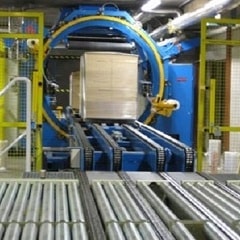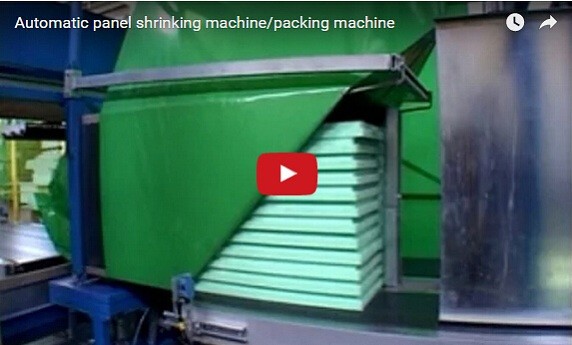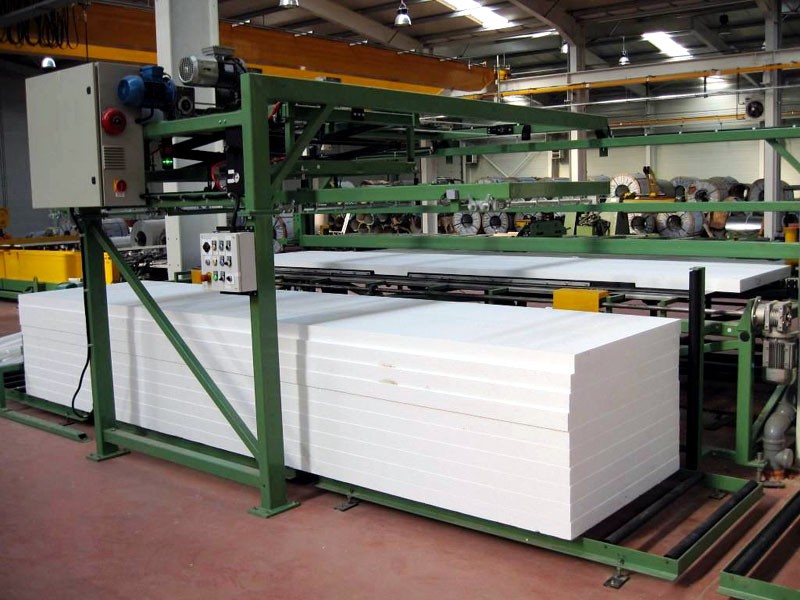Optimizing Packaging Processes for EPS and MDF Panels: A Guide to Modern Machinery
Packaging large-format panels like Expanded Polystyrene (EPS) and Medium-Density Fibreboard (MDF) presents unique challenges for manufacturers. Ensuring product integrity from the factory floor to the end-user requires robust, efficient, and appropriate packaging solutions. Different applications demand different levels of protection and automation. This guide explores various machinery options designed to handle and protect these valuable building and insulation materials.
Understanding the specific requirements for EPS panel packaging and MDF board wrapping is crucial for selecting the right equipment. Factors include panel dimensions, required protection level (from dust, moisture, scratches, impacts), handling methods, and desired throughput speed.
Horizontal Orbital Wrapping Solutions
Orbital wrapping offers a common and effective method for bundling and securing panel stacks.
1. Standard Horizontal Orbital Stretch Wrappers (e.g., E1800 Type)
These machines are designed to apply wrapping material circumferentially around the panel stack as it moves horizontally along a conveyor.
<img src="https://www.fhopepack.com/uploads/Horizontal-pics/horizontal-orbital-stretch-wrapper-e1800.jpg" alt="E1800 Type Horizontal Orbital Stretch Wrapper for Panels"/>
- Process: Panels, often stacked, are fed into the wrapping ring via conveyors. Protective rollers may centralize the load before wrapping. Press-down rollers can stabilize the stack during the wrapping cycle.
- Materials: Common wrapping materials include stretch film, Polyethylene (PE) film, or woven tape, depending on the required strength and protection.
- Features: Photo sensors can detect panel height for automated adjustment, ensuring efficient material usage.
- Application: Suitable for securing stacks for transport and providing basic protection against dust and shifting.
Key considerations for this type include optimizing film tension and overlap for secure EPS panel packaging and MDF board handling.
2. Orbital Wrapping with Top Film Covering
For enhanced protection against environmental factors, orbital wrappers can be configured to apply a top sheet before the main wrapping cycle.
- Process: A layer of PE film is dispensed over the top surface of the panel stack prior to entering the orbital wrapping ring. The subsequent orbital wrap secures this top sheet.
- Benefit: This creates a more enclosed package, significantly improving protection against moisture, dust, staining, potential combustion sources during storage, and surface scratching.
Full Enclosure Systems: Six-Sided Panel Protection (Bale Wrapping Concept)
When maximum protection is required, systems designed for complete six-sided wrapping are employed.

- Process: This often involves a combination of wrapping stages. Typically, the panel stack is first wrapped longitudinally (along its length). Then, the package is transferred, often via a turntable, for transverse wrapping (across its width). Some systems utilize film carriages capable of 90-degree rotation to achieve this.
- Benefit: Results in a fully sealed package, offering the highest level of protection against environmental contaminants and physical damage during handling and storage. Ideal for sensitive materials or long-distance shipping.
Shrink Wrapping Systems for Panels
Shrink wrapping provides a tightly conforming package by applying heat to shrink a polymer film around the product.
1. Sleeve Wrapping and Back Sealing
This method creates a "sleeve" of film around the product, sealed at the back.



- Process: Stacked panels are enveloped in a sheet of PE film. A heated bar cuts the film and seals it along the back (or bottom) of the package. The enclosed package then passes through a large shrink tunnel where controlled heat shrinks the film tightly around the contours of the panel stack.
- Features: Integrated cutting and sealing provides efficiency. Large tunnels accommodate sizable panel stacks. Post-shrink rollers located at the tunnel exit can press the film edges for a neater, tighter finish.
- Benefit: Creates a secure, relatively tamper-evident package with good protection.
2. Flexible Shrink Systems: Side-Seal Technology (e.g., E Series Type)
Side-seal shrink wrappers offer flexibility for varying product dimensions.
- Process: Panels are typically fed through a curtain of PE film. Sealing bars close along the sides of the package (and often across the trailing edge) to fully enclose the panels. The package then proceeds through a shrink tunnel. Post-shrink side rollers may press the sealed edges.
- Benefit: These systems are highly adaptable, accommodating frequent changes in panel length and width with relative ease due to the side-sealing mechanism. They provide complete enclosure, offering excellent protection against environmental factors.
Integrating Packaging: Automated Panel Handling and Packing Lines
For high-volume production, integrating packaging machinery into a fully automated line maximizes efficiency and minimizes labor.
<img src="https://www.fhopepack.com/Stretch%20wrapping%20machines/Stretch%20wrapping%20machine/Horizontal-orbital-stretch-wrapping-machine-(2).jpg" alt="Automated EPS panel packaging line with orbital wrapper"/>
An automated panel packaging line can incorporate various modules:
- Infeed Conveyors: Transport panels from the production line.
- Vacuum Lifters/Manipulators: Safely handle and transfer panels.
- Automatic Stackers: Accurately stack panels to predetermined heights. These are often programmable to handle different panel dimensions and stacking configurations.
- Strapping Machines (Optional): Apply horizontal or vertical straps for initial stabilization before wrapping or shrinking.
- Wrapping/Shrinking Machine: The chosen technology (orbital wrapper, shrink wrapper) integrated into the line flow.
- Palletizers (Optional): Automatically place finished packages onto pallets.
- Outfeed Conveyors: Move finished pallets or packages to warehousing or shipping areas.
Benefits of Automation:
- Increased Throughput: Matches packaging speed to production output.
- Reduced Labor Costs: Minimizes manual handling requirements.
- Improved Consistency: Ensures uniform package quality and protection.
- Enhanced Safety: Reduces risks associated with manual lifting and handling of large panels.
- Seamless Integration: Connects directly to panel production output for continuous flow.
Such automated panel packaging systems are designed for materials like sandwich panels, EPS panels, and EPP panels, providing a comprehensive solution tailored to specific production rates and packaging requirements.
Selecting the Optimal Panel Packaging Machinery
Choosing the right packaging machinery depends on a thorough assessment of needs:
- Product Characteristics: Panel type (EPS, MDF, sandwich, etc.), dimensions, weight, fragility.
- Protection Requirements: Level of protection needed against moisture, dust, UV, impacts.
- Throughput: Required packaging speed (panels or packs per hour) to match production.
- Operational Environment: Space availability, existing line configuration.
- Budget: Capital investment and ongoing operational costs (materials, energy, maintenance).
- Level of Automation: Degree of automation desired, from standalone machines to fully integrated lines.
By carefully considering these factors, manufacturers can invest in EPS panel packaging solutions and MDF board wrapping machines that enhance product protection, improve operational efficiency, and ensure customer satisfaction. Modern packaging technology offers versatile options to meet the diverse needs of the panel manufacturing industry.